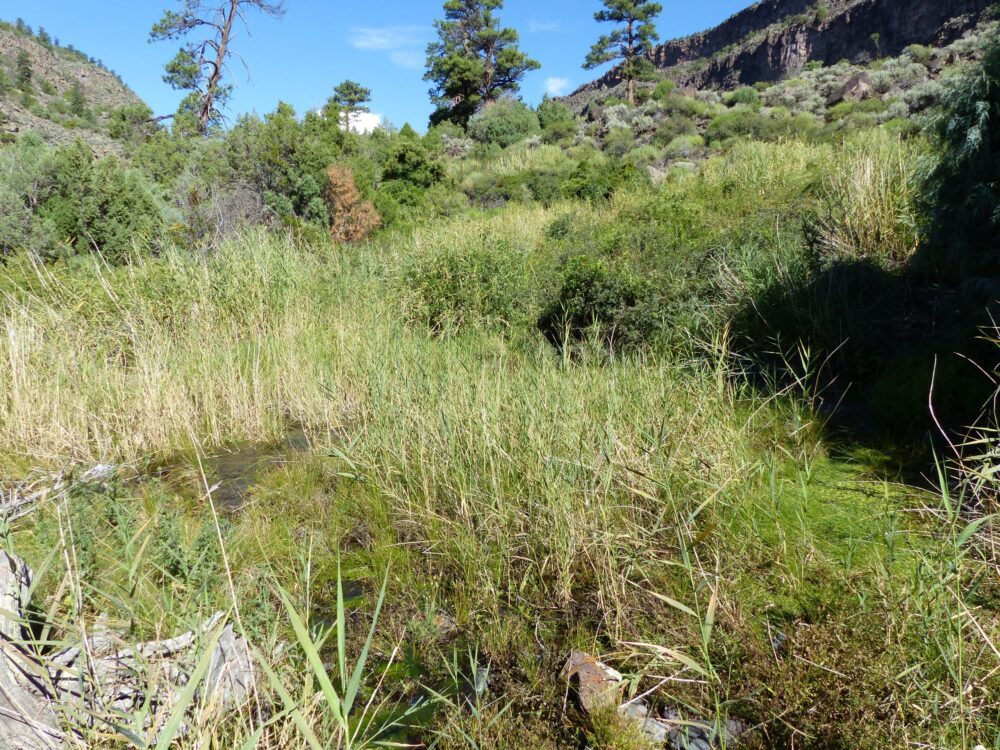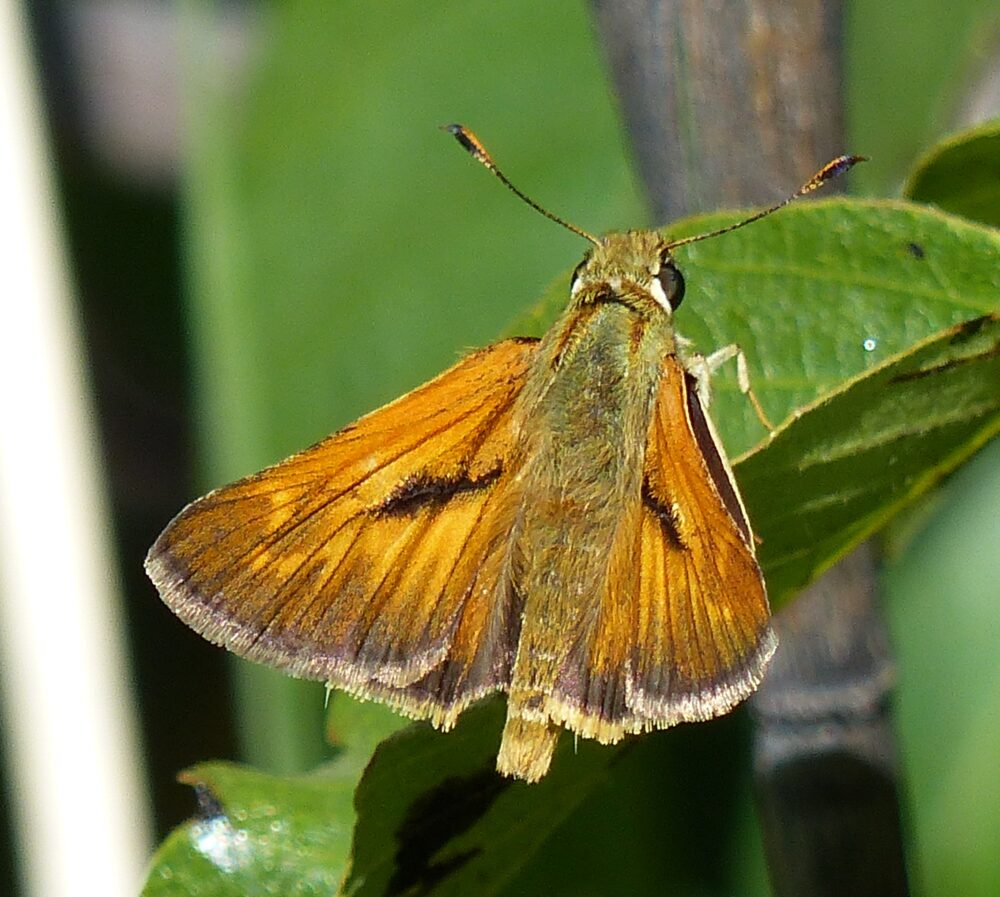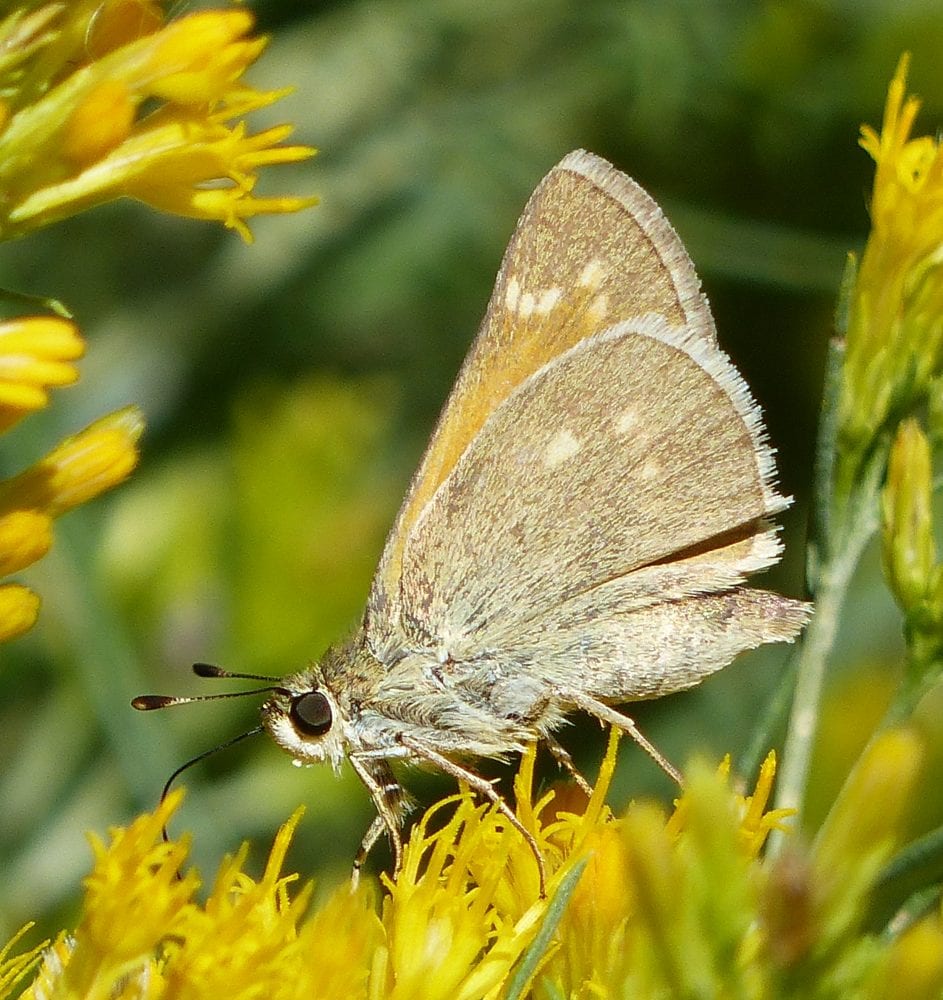By Steve Cary, July 31, 2020
Howdy New Mexico Butterflyers:
The latest newsletter of the Native Plant Society of New Mexico (NPSNM) arrived in my inbox this last week and I was happy to see it! I have been a member for decades, have given butterfly walks and talks at annual NPSNM conferences, and consider them one of the best investments of my tax-exempt charitable contributions in New Mexico.
One informative newsletter feature is the “Conservation Corner” and in this current edition, Rachel Jankowitz led off with a story about a plant that is essential for a very cool butterfly in New Mexico. The plant is Common Reed (Phragmites australis; Poaceae), a head-high grass that lives in emergent wetlands, on stream banks, on acequia banks, in marshes, and in other wet habitats in New Mexico and around the Southwest, actually nationwide, actually worldwide, hence the ‘common’ appellation.
Common Reed is the sole known larval host plant (that’s what its caterpillars eat) for Yuma Skipper (Ochlodes yuma). Yuma Skipper occurs in colonies throughout most of the American Southwest and Intermountain West, but colonies of Phragmites and Yuma are isolated and disconnected because the reed needs something that is scarce in the region: water. As a consequence of those habitat constraints, Yuma Skipper is confined to a very small area in New Mexico: the Rio Grande Gorge near Questa, in Taos County.

On July 23, 1984, my friend Jerry Jacobi invited me to join him and a small party of ecologists and hydrologists on a trip down into Taos County’s Rio Grande Gorge. The first 50 miles of the Rio Grande south from the Colorado border had been designated a National Wild and Scenic River in 1968, the first area in the US to be so designated. In 1984, we accessed the Gorge bottom on foot by way of a trail heading off the rim of the Taos Plateau southwest of Questa. Over the centuries, trails in and out of the gorge were created and maintained first by Native people, then by sheepherders, and subsequently by fishermen. Jerry and his colleagues were there on New Mexico Environment Department (NMED) business, checking the quality of water emanating from Big Arsenic Springs (its name does make a person wonder). Jerry invited me to join the group because he is a great friend with whom I would conduct dozens of entomological outings over the coming decades. Recently when I reminded him of this long-ago event, Jerry said it feels like it might as well have been back in 1884 — time does fly.
As a water resources professional myself, though between jobs at the time, I was interested in the water quality issues because the Molycorp mine and mill tailings complex was upstream. While helping NMED staff get their water samples, I followed my instincts and made note of the butterflies that were present (there was no rule against it — I checked). One in particular got my attention. I was only three years into my New Mexico butterfly avocation, but I studied them passionately and this skipper was unlike anything I had seen before, or even expected to see.
I returned on my own a couple of weeks later and captured a male and a female. After making some semi-educated guesses as to what they might be, I sent them to my Rocky Mountain butterfly guru at the time, Dr. Ray Stanford, in Denver. Ray looked at them and shared them with other experienced Colorado lepidopterists, who performed a quick microscopic examination of the genitalia, and they concluded it was Ochlodes yuma, the Yuma Skipper.

Yuma Skipper had never been seen in New Mexico before. Moreover, these Rio Grande Gorge Yuma Skippers looked somewhat different from Yuma Skippers in private and museum collections at the time. Standard Yuma Skippers from California and the Great Basin (the nominate subspecies) were unmarked bright yellow-gold on the underside and orange-gold above, with a few dark marks. The New Mexico version was more darkly marked on the upperside; undersides were frosted ochre with a faint band of a pale spots that were completely absent from the nominate subspecies.
Sensing we were onto something new, I read what I could to learn more about Yuma Skippers: eggs are placed on leaves of Phragmites australis and larvae cut, roll, and silk leaves together to engineer a hanging shelter where they spend nights and eventually pupate. Adults nectar at flowers, but rarely wander far from the host reeds. Our Gorge colony of Yuma Skippers matched the typical life history for the species as a whole, its one annual flight on the wing flying from late July into early September. With his encouragement, Ray and I described this as a new subspecies: Ochlodes yuma anasazi (Cary and Stanford 1995). In common parlance, call it ‘Anasazi’ Yuma Skipper or Anasazi Skipper.
As a geographer, I was and remain fascinated by the colony’s location in the depths of the Gorge. Phragmites occurs elsewhere in New Mexico without being chewed on by Yuma Skippers. The Gorge sustains the only Yuma Skipper colony in the Rio Grande drainage and the only colony in North America east of the Continental Divide. At 6,600 feet elevation, it persists at a higher altitude than any other known Yuma Skipper colony. This only provoked more questions. How extensive was the Gorge colony? How did it get there? What was it about that location that allowed them to live there?
In 2010, an opportunity arose to study the Anasazi Skipper colony in more detail. Back in 1997, friends John Pfeil, Randy Merker, and I formed a small non-profit, the Natural Resource Institute (NRI), which we used as a platform from which to obtain grants to conduct natural resource research and education activities on our own time. Biologist and GIS specialist Linda DeLay later joined the group and in 2010 we were funded by the New Mexico Department of Game and Fish to study what appeared to be a localized, rare creature that might warrant conservation attention: the Anasazi Skipper. After the Gorge was included in the new Rio Grande del Norte National Monument, the Taos Field Office of the U. S. Bureau of Land Management provided a second round of funding in 2015 in collaboration with the Institute for Applied Ecology, an fantastic local Santa Fe non-profit.
Those generous grants allowed us to spend a lot of field time in the spectacular Rio Grande Gorge tracking down and mapping patches of Common Reed, mapping occurrences of Anasazi Skipper, detailing its life history, studying its dispersal capabilities, and evaluating threats and risks it confronted. We hiked the difficult terrain and may have neared heat stroke a few times. Linda remembers “the thrill of navigating the Rio Grande in our white-water rafts, trying to keep one eye on the Phragmites that hugged the shore and one eye on the river. Who will be the first to find evidence of Anasazi Skipper among or near the reed? How exciting it was to rummage through the blades of leaves, once we did make a landing, to find a neatly rolled tent that a skipper larva made for a home.”
John said the other day: “It was a real joy to participate with NRI on the Anasazi Skipper study. Working with the crew in the Rio Grande Gorge . . . was a feast for the eyes and spirit; and strategizing how to protect our rarest butterfly was a challenge for the brain.”
We were able to confirm that although the Phragmites is more widespread along the Gorge, Anasazi Skippers occupy only a 15-mile reach of the Gorge. A mark/recapture study, staffed chiefly by awesome volunteers, allowed for a crude population estimate of 1,500 to 3,000 individual Yuma Skippers in 2018 (NRI 2019). The population seems to be centered at the Big Arsenic Spring complex which is fed by waters emanating from the Red River Fault and has the best patches of Common Reed in the Gorge. We never found a Skipper more than a mile from any Phragmites stand. With Anasazi Skipper so intimately linked to Common Reed, we concluded that its persistence into the future depended on persistence of large patches of the Reed, which relied in turn on a stable supply of water. As to the issue of why here, other than the presence of the Reed, we postulated that the dark basalt walls of the Gorge may foster a supportive (i.e., warmer) microclimate, while the presence of springs and Reed patches up away from the valley bottom might protect them from the coldest temperatures.

Anasazi Skipper is one of the rarest butterflies in New Mexico and it is contained within one of the smallest habitat areas for any butterfly species in New Mexico. Nevertheless, Anasazi Skipper seems to be adequately protected in the Gorge. It persists now under a conservation-oriented land management program for the Rio Grande del Norte National Monument. Theoretically, an overly passionate butterfly collector could decide to go get all the Anasazi Skippers, but the difficult terrain in their breeding habitat should prevent a damaging take of specimens. Climate warming and drying is a larger concern.
And one additional threat is hard to gauge, as Rachel Jankowitz underscored in her excellent NPSNM “Conservation Corner” article. As a worldwide plant, Phragmites australis exists in multiple genotypes. The native genotype in the Gorge is one we know Anasazi Skipper larvae can eat just fine. Elsewhere in the US, however, exotic Old World Phragmites genotypes have been brought over from Europe or Asia, probably via ocean transports, and have become invasive, particularly in coastal estuaries. Local resource managers seek to protect their local ecosystems by reducing or eliminating the invasive Phragmites genotypes. I am as opposed to invasive exotic weeds as anyone else and I hope New Mexico resource managers are, too. We just need to be sure that resource managers for the Gorge do the appropriate genetic studies before taking any Phragmites management action that might make life difficult for Anasazi Skippers. NRI recommended that a baseline genotype analysis be done for Gorge Phragmites patches so their identity is known in advance. If a foreign Phragmites genotype were to invade the area, would we even recognize it? More importantly, would Anasazi Skipper caterpillars eat it?
If you want to see Anasazi Skippers, August is the time to make the effort and now you have some of the history and context. Follow directions to BLM’s Wild Rivers Recreation Area, a great location that typically allows camping, but probably not during the ongoing COVID pandemic. The driving route takes you north from Questa, west through the little settlement of Cerro, then south to the visitor center and camp loop. The road is paved the entire way. You’ll see campgrounds, pull-offs and trailheads along the west limb of the loop road, nearest the Gorge rim. Along the roadside there is usually a lot of nectar in the form of horsetail milkweed, which pulls in a lot of Anasazi Skippers. By late August, rabbitbrush is coming into bloom as milkweeds senesce. Things may be quite dry there this year, so I guarantee nothing except great views.
If you want to hike down to Big Arsenic Springs to see the Skippers in and around their Phragmites host plants, please think about it and prepare carefully. The hike is 2.4 spectacular miles from rim to Springs with easy, moderate and difficult portions and a net drop of 800 vertical feet. Climbing out can be a challenge on hot afternoons when heat radiating from black basalt canyon walls can roast your brain. Word to the wise: bring plenty of water and start your climb out well before noon. As a reward for making the journey to Wild Rivers, you might find Mead’s Wood-Nymph, too.
If you are not already a member of NPSNM, I strongly recommend you join up. If you like butterflies, you must like native plants, too. You don’t get the native flyers without the native photo-synthesizers.
Stay safe out there!
Cary, S. J., and R. E. Stanford. 1995. A new subspecies of Ochlodes yuma (W. H. Edwards) with notes on life history and historical biogeography. Bull. Allyn Mus. 140. 7 pp.
Natural Resource Institute. 2019. Studies of Anasazi Skipper (Ochlodes yuma anasazi) and Monarch Butterfly (Danaus plexippus) at Wild Rivers Recreation Area, Bureau of Land Management, Taos County, New Mexico.

Great skipper adventure! Thanks,Steve, I’m ready for a Questa trip!